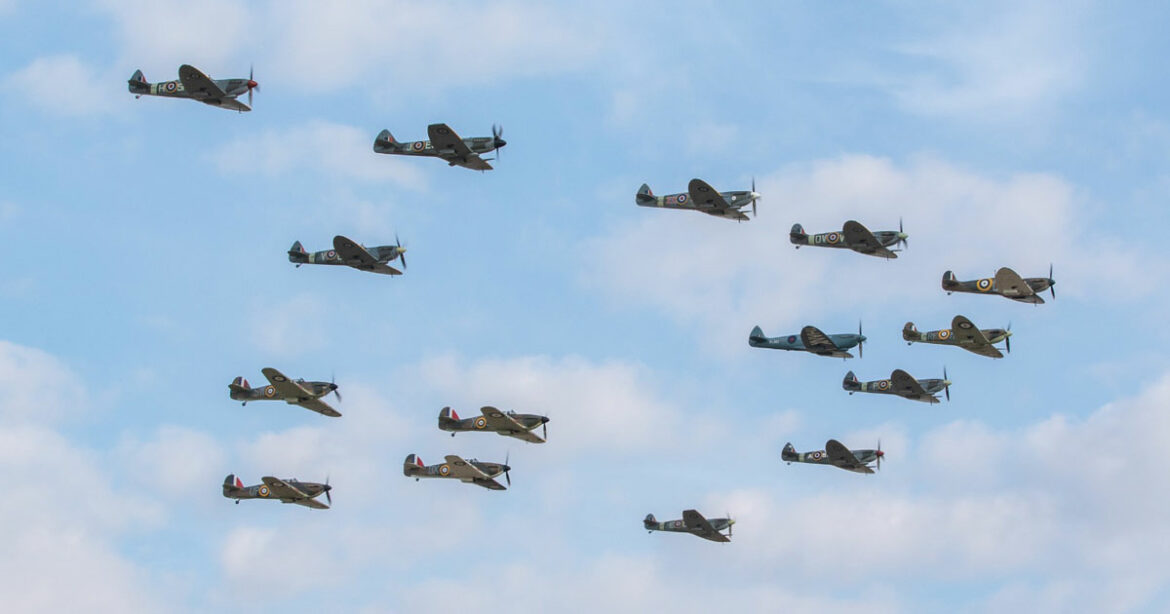Image © IWM
Each summer, Imperial War Museum Duxford opens its airfields to the public for an extraordinary series of events that bring aviation history to life. Flying season offers the opportunity to discover the fascinating feats of engineering behind a dizzying number of aircraft, many of which played a fundamental role in the First and Second World Wars.
Arriving at Duxford’s first air show since 2019, I notice a real buzz, as families of all ages roam the vast expanse of tarmac that runs in parallel with the runway. The atmosphere is festival-like, with a steam fairground at one end of the airfield providing music and merriment for children and the young at heart. There are dozens of marquees selling flight jackets, caps and aviation-themed memorabilia, with friendly faces from organisations such as The British Model Flying Association, British Drone Flyers and living history group Ops 39-45 also enlivening the scene. A trio of musicians parades up and down the concourse as visitors stroll between food stands and admire the planes lined up along the edge of the airfield, where pilots laze on the grass around their shiny aircraft.
I get a chance to speak to one of them, Wandert Brandsen, a pilot from the Netherlands touring the UK with the Stichting Fokker Four. “We’re all volunteers, all ex-air force pilots,” he explains. “Some of us have different jobs now and some are retired, so for us this is just a hobby – a week of holiday more or less! It’s great to come and fly at an event like this, especially when you’ve done the display and get to see people waving and applauding as you taxi back – it’s a really good feeling.”
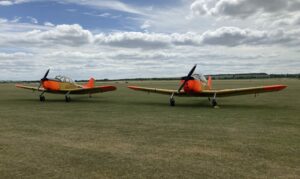
Two Fokker S-11 Instructors
Quizzing him about the aircraft he will be flying that day, one of four Fokker S-11 Instructors, he explains that they were built at the start of the 50s and used as training aircraft for the Dutch air force: “From an instructor’s point of view, they’re great because you can easily see the student flying and can pay attention to what they’re doing, so you can spot what they do wrong and help them improve their performance.” Asked how they compare to modern aircraft, he tells me: “They’re very old, so it’s all hands and feet work – no computers, nothing like that. This is real flying; you can feel the aircraft respond to everything you do, and you can see what’s happening. Whereas, with a modern aircraft you are essentially controlling a computer which controls the plane.”
It’s almost like sitting in a steam locomotive
Continuing along the airfield, we meet another pilot, Martin Tesli from the Norwegian Air Force Historical Squadron, who will be flying alongside the Mikoyan-Gurevich MiG-15UTI in the de Havilland Vampire FB.52. “The de Havilland Vampire is the world’s first single-engine jet fighter aircraft,” Martin tells me, after inviting me to take a seat in the cockpit (a manoeuvre that requires some minor athleticism on my part, due to the absence of a door in the side of the aircraft). “It was built in the UK and first flew in 1943, during the Second World War – so it’s definitely old technology. It’s one of the very few single-seat Vampires that fly in Europe right now, and it’s also one the only wooden jet fighters. Yes, you’re sitting in a plywood jet fighter! Back then they didn’t have all the materials we have today, so they had to make the most of what they had.”
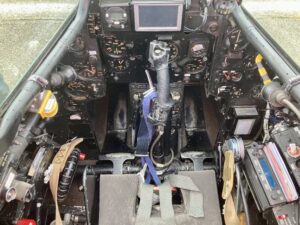
Inside the de Havilland Vampire
Fascinated by the constellation of dials in front of me, I ask what it is that I’m looking at: “Inside you can see that there’s a lot going on – there are lots of gauges!” he laughs. “It’s almost like sitting in a steam locomotive, there are so many dials and levers, and the aircraft even sounds a bit like a steam locomotive when you fly it. There are instrument gauges showing the temperature of the turbine (a feature of jet engines); then you have five fuel tank indicators down there; and that’s the start button on the side. The peddles at your feet steer the rudder; moving the stick in front of you left to right steers the ailerons at the tip of the wing – that’s to do the roll manoeuvre. Moving the stick back and forth controls whether you’re going up or down.
If you don’t know your history or where you’ve come from, you’re likely to make the same mistakes again
“We’re going to be flying her today and showing what jets of that age were able to do.” says Martin. “By taking part in an air show like this we aim to share the aircraft’s history and honour the people that went ahead of us, because if you don’t know your history or where you’ve come from, you’re likely to make the same mistakes again,” he reflects. “Especially now, with the war in Europe, I think it’s really important to remember what we had to go through back then. That’s why it’s a real privilege to be able to come and do these shows and share that with people.”
With some time to spare before the air show commences proper, I head over to see the BAe146 Statesman ZE701 – one of the two BAe146s used to transport the royal family, government ministers and senior military personnel between 1986 and 2022. Over the years, this plane was occasionally flown by the Duke of Edinburgh and Prince Charles; more recently, it flew the Brexit papers from Brussels to London. Taking a guided tour inside, I receive the full royal treatment – invited to peer into the cockpit, take a seat in the Queen’s very own chair and explore the dressing room towards the back of the plane, from which Her Majesty would emerge before descending those iconic steps (sometimes followed by her corgis, who used to travel with the Queen and have the run of the plane!).
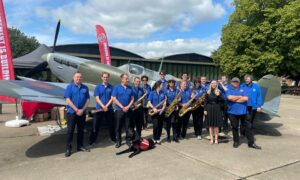
Bader’s Big Band
As I’m leaving the ZE701 I happen to bump into the leader of the Bader’s Big Band, who are performing jazz numbers in one of the hangars throughout the day. “We’re predominantly set up of people with disabilities, usually limb disabilities or mental health issues,” musical director Paul Taverner tells me. “The band was set up by Charley Bickers, who was the step-grandson of Douglas Bader, a double amputee in World War Two. He set up the band so that people with disabilities could benefit from playing in a tight community of musicians – and it turns out that the musicians we have are all excellent and make a wonderful sound! We play all sorts of stuff, from Street Life to funk and Glenn Miller and Duke Ellington. A lot of the music is jazz improvisation, too, so the players will stand up and make it up as they go along!”
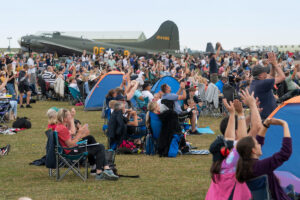
Audiences watching the air show © IWM
“The players come from all around the country,” adds Vicky, Paul’s wife – who also plays tenor sax in the band, “so, instead of practicing every week, we meet around four times a year for an entire weekend. It’s a very supportive environment, and a close-knit community of players. The connection with Douglas Bader makes it great to come to something like this, because we’re playing in the hangar that Douglas Bader apparently flew from!” she adds. The Bader’s Big Band will be back for the Battle of Britain Day in September.
After grabbing a bite to eat, I find a spot with a good view before the flying begins. What comes next is nothing short of spectacular: Approximately four hours’ worth of flying with jaw-dropping acrobatics, from nose-dives to loop-the-loops – and plenty of smoke for added drama.
You can get a piece of the action at various events over the summer, including the Battle of Britain Air Show on 10 and 11 September, plus flying days and evenings in July and August. Head to IWM Duxford’s website to find out more.

